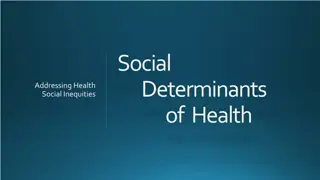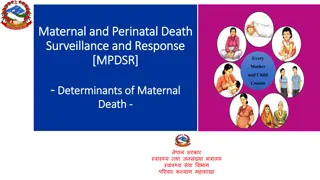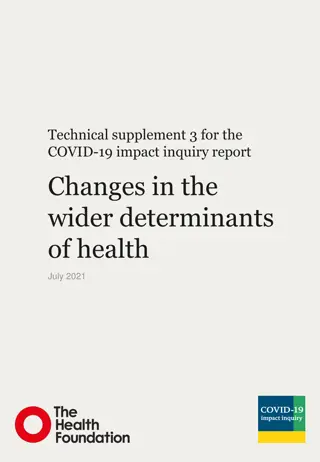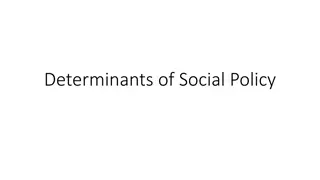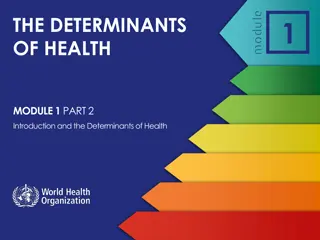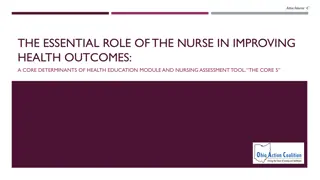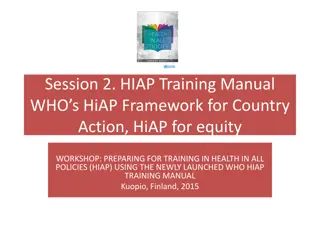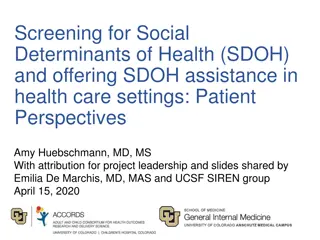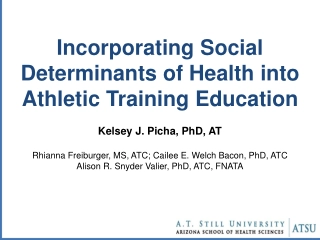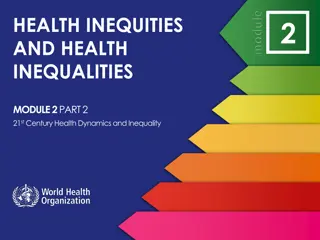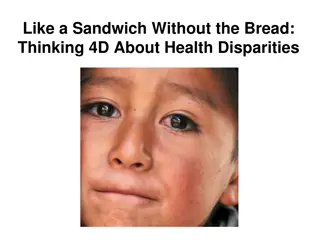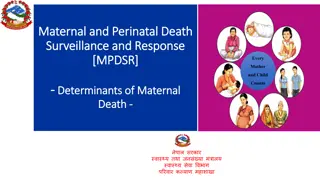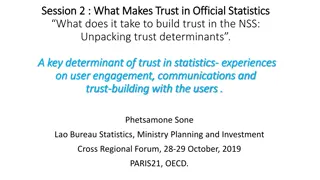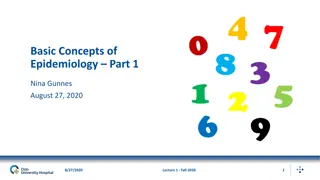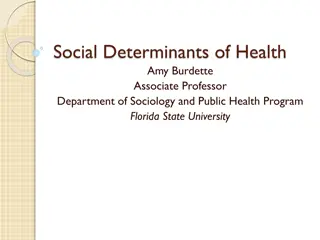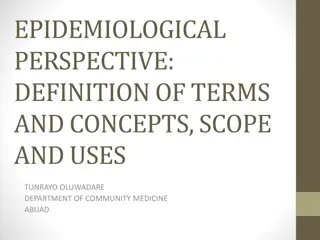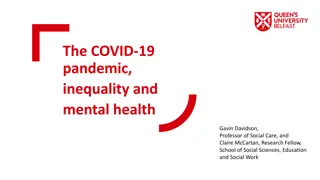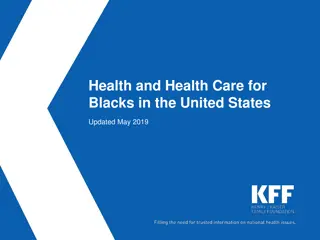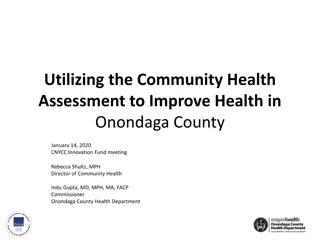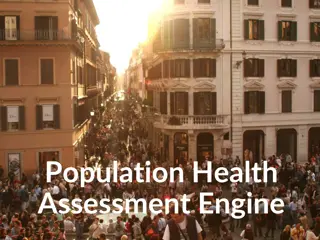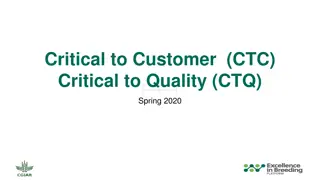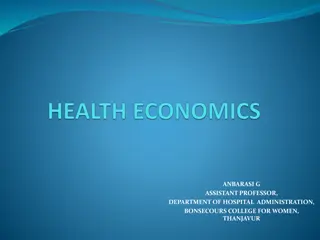Understanding the Wider Determinants of Health in the UK: A Critical Perspective
Exploring the impact of various societal factors on health outcomes in the UK, this report emphasizes the need to address wider determinants such as jobs, housing, discrimination, and poverty. By framing health communications effectively and highlighting inequalities, we can garner support for policies aimed at improving public health across the nation.
Download Presentation

Please find below an Image/Link to download the presentation.
The content on the website is provided AS IS for your information and personal use only. It may not be sold, licensed, or shared on other websites without obtaining consent from the author. Download presentation by click this link. If you encounter any issues during the download, it is possible that the publisher has removed the file from their server.
E N D
Presentation Transcript
A matter of life and death: explaining the wider determinants of health in the UK The Health Foundation and FrameWorks UK April 2022
April 2022 A matter of life and death: explaining the wider determinants of health in the UK Why we need to tell a new story about health Almost every aspect of our lives our jobs, homes, access to education, public transport and whether we experience poverty or racism impacts our health and, ultimately, how long we will live. These factors are often referred to as the wider determinants of health. In the public and political debate about how to improve health in the UK, the wider determinants are often left out or misunderstood. People think of health in highly individualistic ways; it s the food we eat and how much we exercise.
April 2022 A matter of life and death: explaining the wider determinants of health in the UK Building support to address health inequalities When people struggle to see how jobs, homes, hardship and discrimination link to health, they are less likely to support, and demand, the policies and actions that are needed to start addressing these issues. We need to frame health communications to tell a more powerful story a story that increases people s understanding of the role of the wider determinants of health, and builds support for the policies needed to reduce health inequalities and improve health across the country.
April 2022 A matter of life and death: explaining the wider determinants of health in the UK What is framing? Framing is making choices about what we say and how we say it. It is what we emphasise, how we explain an issue, and what we leave unsaid. These choices affect how people think, feel and act. Unlike a set of key messages, frames can be used and adapted to a variety of different contexts; enabling us to tailor communications for different audiences and channels while continuing to talk about our issue in a consistent way.
April 2022 A matter of life and death: explaining the wider determinants of health in the UK An evidence-based framing strategy This framing strategy centres on making the issue more tangible for people by using explanation: 1. We need to start by explaining why the wider determinants of health matter. In the poorest parts of the UK, people are dying years earlier than people in wealthier areas. It s a matter of life and death we need to say so. 2. We need to go deep in our explanation of the issue to show how/why our health is shaped by the wider determinants, and why experiences are unequal across the country. 3. We need to be solutions-focused in our communications and explain how these issues can, and should, be solved. 4. We show how and when to bring certain key issues into the new story, specifically: the NHS, racism and discrimination, and the impact of the pandemic.
April 2022 A matter of life and death: explaining the wider determinants of health in the UK 1. Show why the wider determinants of health matter To increase support for policies and action on the wider determinants of health, we need to start by showing why people should care. Be clear that this is a matter of life and death. What to do Lead by clearly stating what s at stake: people in parts of the UK are dying earlier than they should and there are wide inequalities in life expectancy in the country. Connect this statement of facts with the need to address the social and economic conditions that are harming health and cutting lives short in the first place. Follow up with an explanation of how the wider determinants of health shape life expectancy. Use one or two examples rather than attempting to explain every way the wider determinants shape health.
April 2022 A matter of life and death: explaining the wider determinants of health in the UK 1. Show why the wider determinants of health matter Tips for communicators Avoid adding complexity with concepts like disability-free life expectancy or healthy life expectancy . Most people don t have a clear sense of what these terms refer to. As a result, using them without clearly and simply defining them is likely to create noise that will make it harder to get key points across. Situate data and statistics within a broader narrative. Don t expect facts and figures to speak for themselves. On its own, data showing gaps in life expectancy does not shift how people think and reason. If you don t provide clear ways to help people to make sense of facts and data, people will rely on their existing understandings of the issue and will come up with their own narrative to understand what those facts and data mean.
A matter of life and death: explaining the wider determinants of health in the UK April 2022 2. Harness the power of explanation Most people fail to understand how the world around us shapes our health. Without this understanding, people: default to the idea that it s just the way things are think the problems are too big and complex to be tackled fill in the gaps with narratives that already feel familiar to them like it s up to individuals to make better choices . We can increase understanding by 1) using a building blocks metaphor or 2) taking a deep-dive explanation into one of the wider determinants of health.
April 2022 A matter of life and death: explaining the wider determinants of health in the UK 2. Harness the power of explanation 1) Compare the process of building a healthy society with that of building a sturdy building: To create a healthy society, we need all of the right building blocks in place: stable jobs, good pay, quality housing and education. These building blocks give people a solid frame to withstand life s shocks and challenges. But right now, the building blocks of our society have weakened, leading some people to have key pieces missing. To prevent people from dying earlier than they should, we need to fix the gaps and make sure everyone has access to a stable job, quality housing, and a good education.
April 2022 A matter of life and death: explaining the wider determinants of health in the UK 2. Harness the power of explanation What to do Focus on the need for strong building blocks to create good health and wellbeing in society. Use the metaphor to explain the ways in which, when these wider determinants are firmly in place, they interact with one another to give the population stability in their lives, empower them to have a voice in what happens to them, and build resilience to circumstances outside of individuals control. Explain existing inequalities in health outcomes with the image of building blocks that have become weak and need replacing, so that everyone can benefit from the whole structure of society.
April 2022 A matter of life and death: explaining the wider determinants of health in the UK 2. Harness the power of explanation Tips for communicators Talk about a building, rather than a house. Make sure people can see that society, rather than health itself, is the building you re talking about, to avoid triggering individualistic thinking about health. Expand and flex the scenario of the building to fit your communications goals. Talk about circumstances and events outside of individuals control as storms and shocks, and how having the right building blocks in place can protect people from them. Make the scenario as dynamic as possible, to give people a sense that something can be done to improve health and life expectancy. You can talk about the building s foundations as part of the story you re telling, but don t make it the centrepiece of your communications.
April 2022 A matter of life and death: explaining the wider determinants of health in the UK 2. Harness the power of explanation 2) Use jobs or housing as anchors to explain how the wider determinants shape health in different ways. Right now, people living in our poorest neighbourhoods are dying years earlier than those in wealthier areas. One of the reasons for this is because low-paid or unstable jobs affect people s physical and mental health. When you re always trying to make ends meet, it can be hard to afford healthy food and decent housing. And constantly worrying about having enough money to eat or pay the rent can lead to anxiety or depression. Increasing pay and job stability would help alleviate the stress of constantly worrying about money, and mean people can pay for the basic things they need to stay healthy like food, and heating. This is one of the steps we need to take to make sure everyone can live the long and healthy life they were supposed to.
A matter of life and death: explaining the wider determinants of health in the UK April 2022 2. Harness the power of explanation What to do Provide a deep-dive explanation of how jobs or housing two of the wider determinants of health the public are most familiar with shape people s health and life expectancy. Zoom in on current job or housing inequalities to explain why some people are much more likely than others to die almost a decade earlier than they should. Extend the explanation and apply the same logic to lesser-known determinants (public transport, education) to increase the scope of your message. Conclude with a call to reduce inequalities on a range of issues to reduce gaps in life expectancy and improve health.
April 2022 A matter of life and death: explaining the wider determinants of health in the UK 2. Harness the power of explanation Tips for communicators Embed your deep-dive explanation within a broader argument about life expectancy. Pick one determinant and make it the central focus of your explanation. Include at least two different ways in which the determinant shapes health in your explanation, but don t aim to always talk about all the ways in which jobs or housing shape health. Talk about lesser-known ways the factor influences health for your chosen determinant at least as often as better-known ones. Make sure to explain why people might be living in overcrowded housing in the first place.
April 2022 A matter of life and death: explaining the wider determinants of health in the UK 3. Show change is possible People feel fatalistic about the possibility of change when it comes to health. To overcome this: 1. Pair explanations of the issue with solutions and a sense of efficacy to help people to see that change is possible 2. Bring the solution in early and explain how it improves health and life expectancy, to build public support for specific policies.
April 2022 A matter of life and death: explaining the wider determinants of health in the UK 3. Show change is possible 1) Pair explanations of the issue with solutions and a sense that we can fix it to help people to see that change is possible. What to do Pair explanations of how the wider determinants of health shape health outcomes with a message that we can fix it. Be explicit about the fact that change is possible. Give concrete examples of how but avoid giving a long list of policy solutions. Instead focus on one or two examples of the types of solutions needed to improve health outcomes.
A matter of life and death: explaining the wider determinants of health in the UK April 2022 3. Show change is possible 2) To build public support for specific policies, bring the solution in early and explain how it improves health and life expectancy. What to do Explain the specific ways in which a specific policy will improve health and life expectancy to: connect the big picture of the wider determinants of health to the role that specific policies can play in it.
April 2022 A matter of life and death: explaining the wider determinants of health in the UK 3. Show change is possible Right now, in the UK, some people are dying years earlier than they should. This is partly due to the chronic stress caused by constantly trying to make ends meet. This is why we need to increase the minimum wage to give people the peace of mind that they will have enough to make it through the month, protecting them from anxiety and depression. When people don t have to worry about whether they can afford to pay the rent and feed their families, their bodies produce fewer stress hormones, which means lower blood pressure and blood sugar and a stronger immune system. In this way, being paid enough can directly protect people from illness. To close the gaps in life expectancy, we need to reduce the chronic stress caused by not having enough to get by. One effective way to do this is to raise the national minimum wage.
A matter of life and death: explaining the wider determinants of health in the UK April 2022 3. Show change is possible Tips for communicators Embed your explanation within a broader argument about life expectancy and health (see slide 16). Make the policy s expected impact the central focus of your explanation. Avoid overcomplicating your argument by bringing multiple policies into the conversation. Talk about lesser-known pathways to health for your chosen policy at least as often as better-known ones. For instance, if you want to make the case for increasing the minimum wage: Lesser-known: If people are fairly compensated for their work, their bodies will produce fewer stress hormones, which will directly protect people from some health conditions. A higher minimum wage will ensure that more people can shape what happens in their lives, which will enhance self-worth and reduce the need for harmful coping behaviours like smoking or drinking.
April 2022 A matter of life and death: explaining the wider determinants of health in the UK 4. Talking about the NHS Messages that focused on the NHS as a way to talk about the importance of the wider determinants of health were, at best, unpersuasive, and sometimes backfired making people less likely to support policies and action addressing the wider determinants of health. Where possible, avoid centring the NHS in communications about the wider determinants of health.
A matter of life and death: explaining the wider determinants of health in the UK April 2022 4. Talking about the NHS What to do Remind the public that the NHS was never meant to go it alone and care for people s health all by itself. Focus on the idea that it was always intended to be part of a larger system that also supported jobs, housing, education, and public transport.
April 2022 A matter of life and death: explaining the wider determinants of health in the UK 4. Talking about the NHS Tips for communicators Explicitly refer to people s attachment to the NHS as an institution. For instance, talk about the NHS we all value and rely on . Mention iconic phrases like from cradle to grave : even unconsciously, these can help people connect the NHS with the UK s post-war endeavour to create a comprehensive system of social welfare. Connect the dots between the NHS and the wider determinants of health explicitly. Don t expect people to do this by themselves. Say something like to ensure that the NHS can fulfil its intended mission, the UK needs a broader system of support to address the social and economic conditions that contribute to poor health . Don t make the NHS the central point of your messages. You don t have to talk about the NHS as part of all your communications about the wider determinants of health. But if you need to, focus on how the NHS was never meant to go it alone.
April 2022 A matter of life and death: explaining the wider determinants of health in the UK 4. Talking about the NHS What didn t work Avoid messages that focus on the NHS being under strain. Messages that focus on the NHS being under strain will likely trigger unhelpful thinking about the institution. The belief that NHS resources are a finite resource can lead people to reason that giving more to some groups inevitably means taking away from others, and lead people to make the distinction between deserving and undeserving ill people Avoid messages that appeal to common sense solutions. The notion of common sense is often used by Conservative politicians to frame messages about a range of social issues. It has also been used by the public health field to argue for action on the wider determinants of health, on the grounds that it doesn t make sense to treat people and send them back to the conditions that made them sick in the first place.
April 2022 A matter of life and death: explaining the wider determinants of health in the UK 5. Talking about racism and discrimination How people in the UK currently think about race, racism, and discrimination People overwhelmingly think about racism as an interpersonal issue, not a systemic one. People mainly understand racism as explicit abuse committed by one individual towards another. Other, more systemic or/and more subtle forms of racism are not on people s minds, which makes them quick to push back against messages asking them to engage with structural racism as a reality, either on the grounds that they themselves are not racist, or that the UK as a whole is not as racist as other countries in the world.
April 2022 A matter of life and death: explaining the wider determinants of health in the UK 5. Talking about racism and discrimination Implications for public health communicators The lack of understanding of what structural racism entails and reluctance to engage with the issue suggests that significant work is needed to build public understanding. Public health can t go it alone. This doesn t mean that public health communicators should shy away from talking about how racism shapes health outcomes and life expectancy in important ways But that these efforts should happen alongside organisations whose work centres on racism to build understanding of structural racism.
April 2022 A matter of life and death: explaining the wider determinants of health in the UK 5. Talking about racism and discrimination The research sets out some useful starting points, with the caveat that more research is needed to create a thorough framing strategy around race and racism in the UK more broadly: 1. Always explain what data about racial inequality means. Don t assume it will speak for itself. 2. Show how racism and discrimination exacerbate wider societal issues, to avoid us versus them thinking. 3. Use chronic stress as a way to start building public understanding of how racism shapes health and life expectancy.
April 2022 A matter of life and death: explaining the wider determinants of health in the UK 5. Talking about racism and discrimination 1) Always explain what data about racial inequality means. Don t assume it will speak for itself. What to do Always situate data and statistics about health-related racial inequalities within a broader narrative and select them carefully. Don t expect facts and figures about race and health to speak for themselves and convey meaning. Avoid using unframed data. Use the frames and recommendations in this brief to contextualise data and tell a clear, consistent story.
A matter of life and death: explaining the wider determinants of health in the UK April 2022 5. Talking about racism and discrimination 2) Show how racism and discrimination exacerbate wider societal issues, to avoid us versus them thinking. What to do Embed your explanation about racism and discrimination within the broader story of the wider determinants of health. Lead with a broader argument about life expectancy and the role of the wider determinants of health. Explain that racism and discrimination make life even harder for some groups. Conclude with the need to deal with the socio-economic conditions that harm health and cut lives short in the first place, and the need to rid our system of the racism and discrimination that harm the health and life expectancy of people who experience racism even more.
April 2022 A matter of life and death: explaining the wider determinants of health in the UK 5. Talking about racism and discrimination 2) Show how racism and discrimination exacerbate wider societal issues, to avoid us versus them thinking. What to do Avoid calling out policies and institutions as racist without explaining what you mean by it. Don t assume that the public shares your understanding of what racism is and how it works.
April 2022 A matter of life and death: explaining the wider determinants of health in the UK 5. Talking about racism and discrimination 2) Use chronic stress as a way to start building public understanding of how racism shapes health and life expectancy. What to do Embed your explanation within a broader argument about life expectancy and health. Lead with the idea that people are dying earlier than they should because society s social and economic conditions are causing chronic stress, which directly shapes people s overall health and life expectancy. Follow up with an explanation of how, for people who experience racism and discrimination in society, these experiences add even more stress to their lives. Conclude with the need to deal with the social and economic conditions that cause chronic stress and cut lives short in the first place, and the need to rid our system of the racism and discrimination that cause more chronic stress for people.
April 2022 A matter of life and death: explaining the wider determinants of health in the UK 5. Talking about racism and discrimination 2) Use chronic stress as a way to start building public understanding of how racism shapes health and life expectancy. What to do Talk about chronic stress to counter individualistic thinking about racism. Connect chronic stress to instances of interpersonal racism as well as structural racism in your explanation. Talk about how people from Black or Asian communities often face racist comments and harmful behaviours from others. Pair this with an example of how the system also makes it harder for people who experience racism to get access to fair pay and job stability, quality social housing or education, or avoid harsh treatment by the police.
April 2022 A matter of life and death: explaining the wider determinants of health in the UK 6. Talking about the pandemic What to do Avoid leading with the effects of COVID-19 on health and life expectancy. This might get people to tune out because they re tired of hearing about COVID-19, or cue narrow understandings of the issue as only related to individual behaviours around diet and exercise. Instead: Make the issue about life expectancy and the fact that some people in the UK are dying earlier than they should. Acknowledge that inequalities in health and life expectancy are a long-standing issue in the UK and explain why that is. Explain how the pandemic has increased existing inequalities after. In other words, use COVID-19 as a way to further emphasise your main point, rather than as your main point.
April 2022 A matter of life and death: explaining the wider determinants of health in the UK Cross-sectoral collaboration is needed for maximum impact on the wider determinants As the public doesn t tend to think of these issues primarily in terms of health, at least in the first place, the public health sector can only go so far by itself when communicating about the wider determinants. Public health needs to work in collaboration with communicators and advocates from other sectors to expand the public s understanding of health and help them think of social and environmental issues. It is crucial for public health advocates to work with communicators from other sectors because they are going to be up against unproductive beliefs and assumptions not only about health, but also each specific issue that a holistic approach to health builds upon.
April 2022 A matter of life and death: explaining the wider determinants of health in the UK Summary To address health inequalities, we need to change the way that we communicate about the wider determinants of health to increase public understanding and build support for policy change. Key to this is harnessing the power of explanation. To build support to address health inequalities, we need to explain the links between jobs, homes and education, and our health. We need to explain how experiencing poverty, racism or discrimination can make our mental and physical health worse.
April 2022 A matter of life and death: explaining the wider determinants of health in the UK Summary We need to explain how solutions like increasing the minimum wage or creating more affordable housing can actively improve health. The way these issues are linked isn t currently top of mind for people in the UK. But by joining the dots to show why this matters, how and why it is happening and how we can improve this, we can change the conversation about health and build support for the action needed to help everyone to live a long and healthy life.


